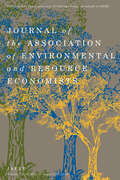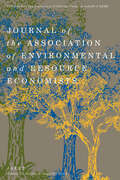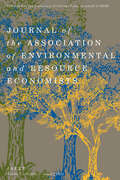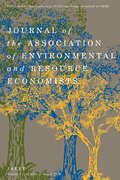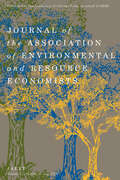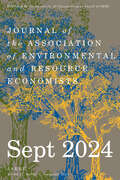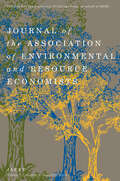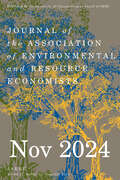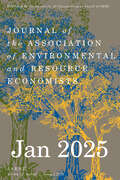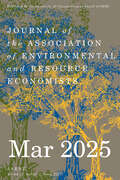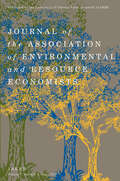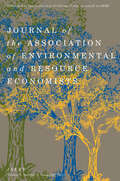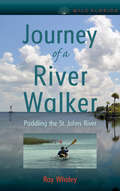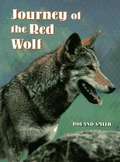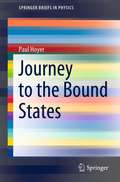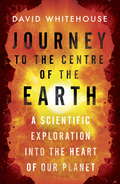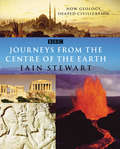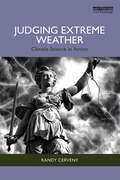- Table View
- List View
Journal of the Association of Environmental and Resource Economists, volume 10 number 5 (September 2023)
by Journal of the Association of Environmental and Resource EconomistsThis is volume 10 issue 5 of Journal of the Association of Environmental and Resource Economists. As an official research journal of the Association of Environmental and Resource Economists, JAERE publishes papers that are devoted to environmental and natural resource issues. The journal's principal mission is to provide a forum for the scholarly exchange of ideas in the intersection of human behavior and the natural environment. Focusing on original, full-length research papers that offer substantial new insights for scholars of environmental and resource economics, JAERE presents a range of articles that are relevant for public policy, using approaches that are theoretical, empirical, or both.
Journal of the Association of Environmental and Resource Economists, volume 10 number 6 (November 2023)
by Journal of the Association of Environmental and Resource EconomistsThis is volume 10 issue 6 of Journal of the Association of Environmental and Resource Economists. As an official research journal of the Association of Environmental and Resource Economists, JAERE publishes papers that are devoted to environmental and natural resource issues. The journal's principal mission is to provide a forum for the scholarly exchange of ideas in the intersection of human behavior and the natural environment. Focusing on original, full-length research papers that offer substantial new insights for scholars of environmental and resource economics, JAERE presents a range of articles that are relevant for public policy, using approaches that are theoretical, empirical, or both.
Journal of the Association of Environmental and Resource Economists, volume 11 number 1 (January 2024)
by Journal of the Association of Environmental and Resource EconomistsThis is volume 11 issue 1 of Journal of the Association of Environmental and Resource Economists. As an official research journal of the Association of Environmental and Resource Economists, JAERE publishes papers that are devoted to environmental and natural resource issues. The journal's principal mission is to provide a forum for the scholarly exchange of ideas in the intersection of human behavior and the natural environment. Focusing on original, full-length research papers that offer substantial new insights for scholars of environmental and resource economics, JAERE presents a range of articles that are relevant for public policy, using approaches that are theoretical, empirical, or both.
Journal of the Association of Environmental and Resource Economists, volume 11 number 2 (March 2024)
by Journal of the Association of Environmental and Resource EconomistsThis is volume 11 issue 2 of Journal of the Association of Environmental and Resource Economists. As an official research journal of the Association of Environmental and Resource Economists, JAERE publishes papers that are devoted to environmental and natural resource issues. The journal's principal mission is to provide a forum for the scholarly exchange of ideas in the intersection of human behavior and the natural environment. Focusing on original, full-length research papers that offer substantial new insights for scholars of environmental and resource economics, JAERE presents a range of articles that are relevant for public policy, using approaches that are theoretical, empirical, or both.
Journal of the Association of Environmental and Resource Economists, volume 11 number 3 (May 2024)
by Journal of the Association of Environmental and Resource EconomistsThis is volume 11 issue 3 of Journal of the Association of Environmental and Resource Economists. As an official research journal of the Association of Environmental and Resource Economists, JAERE publishes papers that are devoted to environmental and natural resource issues. The journal's principal mission is to provide a forum for the scholarly exchange of ideas in the intersection of human behavior and the natural environment. Focusing on original, full-length research papers that offer substantial new insights for scholars of environmental and resource economics, JAERE presents a range of articles that are relevant for public policy, using approaches that are theoretical, empirical, or both.
Journal of the Association of Environmental and Resource Economists, volume 11 number 4 (July 2024)
by Journal of the Association of Environmental and Resource EconomistsThis is volume 11 issue 4 of Journal of the Association of Environmental and Resource Economists. As an official research journal of the Association of Environmental and Resource Economists, JAERE publishes papers that are devoted to environmental and natural resource issues. The journal's principal mission is to provide a forum for the scholarly exchange of ideas in the intersection of human behavior and the natural environment. Focusing on original, full-length research papers that offer substantial new insights for scholars of environmental and resource economics, JAERE presents a range of articles that are relevant for public policy, using approaches that are theoretical, empirical, or both.
Journal of the Association of Environmental and Resource Economists, volume 11 number 5 (September 2024)
by Journal of the Association of Environmental and Resource EconomistsThis is volume 11 issue 5 of Journal of the Association of Environmental and Resource Economists. As an official research journal of the Association of Environmental and Resource Economists, JAERE publishes papers that are devoted to environmental and natural resource issues. The journal's principal mission is to provide a forum for the scholarly exchange of ideas in the intersection of human behavior and the natural environment. Focusing on original, full-length research papers that offer substantial new insights for scholars of environmental and resource economics, JAERE presents a range of articles that are relevant for public policy, using approaches that are theoretical, empirical, or both.
Journal of the Association of Environmental and Resource Economists, volume 11 number 6 (November 2024)
by Journal of the Association of Environmental and Resource EconomistsThis is volume 11 issue 6 of Journal of the Association of Environmental and Resource Economists. As an official research journal of the Association of Environmental and Resource Economists, JAERE publishes papers that are devoted to environmental and natural resource issues. The journal's principal mission is to provide a forum for the scholarly exchange of ideas in the intersection of human behavior and the natural environment. Focusing on original, full-length research papers that offer substantial new insights for scholars of environmental and resource economics, JAERE presents a range of articles that are relevant for public policy, using approaches that are theoretical, empirical, or both.
Journal of the Association of Environmental and Resource Economists, volume 11 number S1 (November 2024)
by Journal of the Association of Environmental and Resource EconomistsThis is volume 11 issue S1 of Journal of the Association of Environmental and Resource Economists. As an official research journal of the Association of Environmental and Resource Economists, JAERE publishes papers that are devoted to environmental and natural resource issues. The journal's principal mission is to provide a forum for the scholarly exchange of ideas in the intersection of human behavior and the natural environment. Focusing on original, full-length research papers that offer substantial new insights for scholars of environmental and resource economics, JAERE presents a range of articles that are relevant for public policy, using approaches that are theoretical, empirical, or both.
Journal of the Association of Environmental and Resource Economists, volume 12 number 1 (January 2025)
by Journal of the Association of Environmental and Resource EconomistsThis is volume 12 issue 1 of Journal of the Association of Environmental and Resource Economists. As an official research journal of the Association of Environmental and Resource Economists, JAERE publishes papers that are devoted to environmental and natural resource issues. The journal's principal mission is to provide a forum for the scholarly exchange of ideas in the intersection of human behavior and the natural environment. Focusing on original, full-length research papers that offer substantial new insights for scholars of environmental and resource economics, JAERE presents a range of articles that are relevant for public policy, using approaches that are theoretical, empirical, or both.
Journal of the Association of Environmental and Resource Economists, volume 12 number 2 (March 2025)
by Journal of the Association of Environmental and Resource EconomistsThis is volume 12 issue 2 of Journal of the Association of Environmental and Resource Economists. As an official research journal of the Association of Environmental and Resource Economists, JAERE publishes papers that are devoted to environmental and natural resource issues. The journal's principal mission is to provide a forum for the scholarly exchange of ideas in the intersection of human behavior and the natural environment. Focusing on original, full-length research papers that offer substantial new insights for scholars of environmental and resource economics, JAERE presents a range of articles that are relevant for public policy, using approaches that are theoretical, empirical, or both.
Journal of the Association of Environmental and Resource Economists, volume 12 number 3 (May 2025)
by Journal of the Association of Environmental and Resource EconomistsThis is volume 12 issue 3 of Journal of the Association of Environmental and Resource Economists. As an official research journal of the Association of Environmental and Resource Economists, JAERE publishes papers that are devoted to environmental and natural resource issues. The journal's principal mission is to provide a forum for the scholarly exchange of ideas in the intersection of human behavior and the natural environment. Focusing on original, full-length research papers that offer substantial new insights for scholars of environmental and resource economics, JAERE presents a range of articles that are relevant for public policy, using approaches that are theoretical, empirical, or both.
Journal of the Association of Environmental and Resource Economists, volume 7 number 3 (May 2020)
by Journal of the Association of Environmental and Resource EconomistsThis is volume 7 issue 3 of Journal of the Association of Environmental and Resource Economists. As an official research journal of the Association of Environmental and Resource Economists, JAERE publishes papers that are devoted to environmental and natural resource issues. The journal's principal mission is to provide a forum for the scholarly exchange of ideas in the intersection of human behavior and the natural environment. Focusing on original, full-length research papers that offer substantial new insights for scholars of environmental and resource economics, JAERE presents a range of articles that are relevant for public policy, using approaches that are theoretical, empirical, or both.
Journal of the Association of Environmental and Resource Economists, volume 9 number 6 (November 2022)
by Journal of the Association of Environmental and Resource EconomistsThis is volume 9 issue 6 of Journal of the Association of Environmental and Resource Economists. As an official research journal of the Association of Environmental and Resource Economists, JAERE publishes papers that are devoted to environmental and natural resource issues. The journal's principal mission is to provide a forum for the scholarly exchange of ideas in the intersection of human behavior and the natural environment. Focusing on original, full-length research papers that offer substantial new insights for scholars of environmental and resource economics, JAERE presents a range of articles that are relevant for public policy, using approaches that are theoretical, empirical, or both.
Journalism, Politics, and the Dakota Access Pipeline: Standing Rock and the Framing of Injustice (Routledge Studies in Environmental Communication and Media)
by Ellen MooreThis book explores tensions surrounding news media coverage of Indigenous environmental justice issues, identifying them as a fruitful lens through which to examine the political economy of journalism, American history, human rights, and contemporary U.S. politics. The book begins by evaluating contemporary American journalism through the lens of "deep media", focusing especially on the relationship between the drive for profit, professional journalism, and coverage of environmental justice issues. It then presents the results of a framing analysis of the Standing Rock movement (#NODAPL) coverage by news outlets in the USA and Canada. These findings are complemented by interviews with the Standing Rock Sioux Tribe, whose members provided their perspectives on the media and the pipeline. The discussion expands by considering the findings in light of current U.S. politics, including a Trump presidency that employs "law and order" rhetoric regarding people of color and that often subjects environmental issues to an economic "cost-benefit" analysis. The book concludes by considering the role of social media in the era of "Big Oil" and growing Indigenous resistance and power. Examining the complex interplay between social media, traditional journalism, and environmental justice issues, Journalism, Politics, and the Dakota Access Pipeline: Standing Rock and the Framing of Injustice will be of great interest to students and scholars of environmental communication, critical political economy, and journalism studies more broadly.
Journey of a River Walker: Paddling the St. Johns River (Wild Florida)
by Ray WhaleyWhen Ray Whaley set out to accomplish his bucket-list goal of kayaking the length of the St. Johns River, it didn’t take long for him to realize he was in over his head. The longest river in Florida, stretching 310 miles between Vero Beach and Jacksonville, the St. Johns had been paddled in its entirety by only a handful of people. Whaley found himself blazing his own trail on an exciting and unexpected adventure. In Journey of a River Walker, Whaley tells the whole story of his experience, from his preparations beforehand to the techniques he learned along the way to his daily escapades and discoveries on the water. Learning from Whaley’s recommendations, along with his mistakes and close calls, readers will gain valuable knowledge that will help them in planning their own paddling trips. Whaley’s journey also highlights the delicate ecosystem of the river and the importance of conserving its environment, raising awareness of the fragile yet critical link between humans and nature. A volume in the series Wild Florida, edited by M. Timothy O’Keefe
Journey of the Red Wolf, First Edition
by Roland SmithThe story of the red wolf's journey from the brink of extinction to its reintroduction to the wild follows the endeavors of the Red Wolf Recovery Program, from the 1971 capture of seventeen endangered wolves to their joyful release.
Journey of the Universe: Christian Responses To Journey Of The Universe (Ecology And Justice Ser.)
by Brian Thomas Swimme Mary Evelyn TuckerThe basis for the Emmy-winning film. &“A wonderful, highly readable account of the history of the universe from the Big Bang through the present moment.&”—Thomas Lovejoy, University Professor in Environmental Science and Policy, George Mason University Through the astonishing combined achievements of natural scientists worldwide, we now have a detailed account of how galaxies and stars, planets and living organisms, human beings and human consciousness came to be. And yet . . . we thirst for answers to questions that have haunted humanity from the very beginning. What is our place in the 14-billion-year history of the universe? What roles do we play in Earth&’s history? How do we connect with the intricate web of life on Earth? In Journey of the Universe, Brian Thomas Swimme and Mary Evelyn Tucker tell the epic story of the universe from an inspired new perspective, weaving the findings of modern science together with enduring wisdom found in the humanistic traditions of the West, China, India, and indigenous peoples. The authors explore cosmic evolution as a profoundly wondrous process based on creativity, connection, and interdependence, and they envision an unprecedented opportunity for the world&’s people to address the daunting ecological and social challenges of our times. Journey of the Universe transforms how we understand our origins and envision our future. Though a little book, it tells a big story one that inspires hope for a way in which Earth and its human civilizations could flourish together. &“What&’s most striking about Swimme and Tucker&’s work is a simple but beautiful assumption: a cosmological orientation opens the human mind to wonder, gratitude, humility, and creativity.&”—Orion
Journey to the Bound States (SpringerBriefs in Physics)
by Paul HoyerThis book is a graduate-level self-study guide of bound states in elementary particle physics and consequently in the standard model. The author first recalls the usual quantum electrodynamics (QED) approach to atoms in terms of Feynman diagrams, which assume free states at asymptotic times. Motivated by general principles and data, he then develops a novel method based on a Fock expansion of bound states in temporal gauge. The properties of relativistic bound states are discussed for Dirac states, atoms in motion, QED in D=1+1 dimensions, and hadrons in quantum chromodynamics (including color confinement). This book provides complementary material for quantum field theory courses and is accessible for graduate students and more senior researchers.
Journey to the Centre of the Earth: The Remarkable Voyage of Scientific Discovery into the Heart of Our World
by David WhitehouseThe journey to the centre of the earth is a voyage like no other we can imagine.Over 3,000 km below the earth's surface an extraordinary inner world the size of Mars awaits us.Dive through the molten iron of the outer core and eventually you will reach a solid sphere - an iron-clad world held within a metal sea and unattached to anything above.At the earth's core is the history of our planet written in temperature and pressure, crystals and minerals . . . Our planet appears tranquil from outer space. And yet the arcs of volcanoes, the earthquake zones and the auroral glow rippling above our heads are testimony to something remarkable happening inside . . .For thousands of years these phenomena were explained in legend and myth. Only in recent times has the brave new science of seismology emerged. One hundred and fifty years after the extraordinary, imaginative feat of Jules Verne's JOURNEY TO THE CENTRE OF THE EARTH, David Whitehouse embarks on a voyage of scientific discovery into the heart of our world.
Journey to the Centre of the Earth: The Remarkable Voyage of Scientific Discovery into the Heart of Our World
by Dr David WhitehouseThe journey to the centre of the earth is a voyage like no other we can imagine.Over 3,000 km below the earth's surface an extraordinary inner world the size of Mars awaits us.Dive through the molten iron of the outer core and eventually you will reach a solid sphere - an iron-clad world held within a metal sea and unattached to anything above.At the earth's core is the history of our planet written in temperature and pressure, crystals and minerals . . . Our planet appears tranquil from outer space. And yet the arcs of volcanoes, the earthquake zones and the auroral glow rippling above our heads are testimony to something remarkable happening inside . . .For thousands of years these phenomena were explained in legend and myth. Only in recent times has the brave new science of seismology emerged. One hundred and fifty years after the extraordinary, imaginative feat of Jules Verne's JOURNEY TO THE CENTRE OF THE EARTH, David Whitehouse embarks on a voyage of scientific discovery into the heart of our world.
Journeys From The Centre Of The Earth
by Dr Iain StewartMan with hammer, rucksack and GSOH offers gritty adventure holidays. Looking for sun, sea, sand and - science. Scheduled to tie in with a major new BBC series, Hot Rocks explores the Mediterranean - the cradle of western civilisation - and discovers alongside its tranquil, sun-lapped shores, one of the most volatile places on an ever-changing earth. The Mediterranean we know today has been forged in a violent crucible of clashing continents, rising mountains, restless seas and a turbulent climate. Millions of Britons are drawn to the Mediterranean every year and whether they go for the beautiful scenery and relaxing beaches or the culture and architecture or food, none of it would be there were it not for geology. Forward-thinking geologist and television presenter Dr Iain Stewart, uncovers the hidden Mediterranean and brings a fresh and dramatic eye to geology to show just why it is that geology should be restored to its rightful place as the grandfather of sciences. From earthquakes and volcanoes to Roman architecture and cuisine, Iain discovers just how geology has shaped our lives and how we can expect it to affect us in years to come.
Journeys Through Paradise: Pioneering Naturalists in the Southeast
by Gail Fishman"This book is for those inhabited by the same desires that drove the early naturalists afield, who yearn to know wilder territory. We read it voraciously, as if in the understanding of how they loved we might also begin to do so, as if in the reliving of their lives we might recapture some vanishing part of the human psyche that must know wilderness."-- Janisse Ray, author of Ecology of a Cracker Childhood "Like the naturalists she profiles, Gail Fishman takes us on an odyssey through a time when the extraordinary diversity of the southeastern United States was first being explored and described. . . . Entertaining."-- Steve Gatewood, executive director, Society for Ecological Restoration, Tucson "Fishman modernizes the men and their explorations by retracing the terrain that they explored, wrote about, drew and painted. The result is an intriguing and appealing lesson in biographical and scientific history and a literary reading experience that will appeal to a wide audience."-- William W. Rogers, professor of history emeritus, Florida State University Following the original steps of pioneering naturalists, Gail Fishman profiles thirteen men who explored North America’s southeastern wilderness between 1715 and the 1940s, including John James Audubon, Mark Catesby, John and William Bartram, John Muir, and Alvan Wentworth Chapman. The book is also Fishman’s personal travelogue as she experiences the landscape through their eyes and describes the changes that have occurred along the region’s trails and streams. Traveling by horseback, boat, and foot, these naturalists--dedicated to their task and blessed with passion and insatiable curiosity--explored gentle mountains, regal forests, and shadowy swamps. Their interests ran deeper than merely cataloging plants and animals. They identified the continent’s foundations and the habits and histories of the flora and fauna of the landscape. Fishman tells us who they were and what compelled them to pursue their work. She evaluates what they accomplished and measures their importance, also pointing out their strengths and failings. And she paints an engaging picture of what America was like at the time. Fishman combines natural history and American history into a series of portraits that recapture the American Southeast as it was seen by those who first tramped through the wilderness and whose voices from the beginning urged the preservation of wild places. Gail Fishman, a freelance writer who lives in Tallahassee, has worked for the Florida Defenders of the Environment, The Nature Conservancy, and the National Audubon Society. She is a volunteer for the St. Marks National Wildlife Refuge and helped form the St. Marks Refuge Association.
Journeys with Plant Spirits: Plant Consciousness Healing and Natural Magic Practices
by Emma Farrell• Presents meditation journeys with specific plant and tree spirits, such as Mugwort, Rosemary, Dandelion, Yew, Elder, and Wormwood • Details how to achieve a calm mind, cleanse your energy field, and connect with your heart in preparation for meditating with the plants • Includes a progressive series of introductory meditations, adapted from wisdom traditions, to lay the foundation for working with plant spirits Our ancient ancestors understood the language of nature, enabling them to communicate innately with plants. By quieting the mind through meditation, we too can tap into the vibratory resonance of plants and receive their wisdom and healing. In this guide, Emma Farrell explains how to take your connection and relationship with nature to a deeper level and access plant spirit healing through meditation with plants. She explores the nature of plant consciousness and how plants perceive, drawing on indigenous and shamanic teachings. She details how to achieve a calm mind, cleanse your energy field, and connect with your heart in preparation for meditating with plants and trees, showing how the plants can support us not only in the cleansing process but also in teaching us how to sense what is in our energy field. Offering a progressive series of preparatory meditations, adapted from wisdom traditions, the author reveals how to lay the foundation for working, communicating, and developing relationships with plant and tree spirits for personal development, spiritual connection, and inner peace. She then presents meditation journeys with specific plant spirits, focusing on specific frequencies within the plant&’s bio-resonance to assist you. For example, the meditation with Mugwort works with the plant spirit&’s qualities of alignment and self-awareness to assist you with grounding and developing inner vision, while the meditation with Dandelion helps you break old habits by working with the plant&’s qualities of release, reconnection, and fearlessness. Revealing how each plant is an expression of the soul force of Mother Nature and carries a unique blend of her medicine and wisdom, this guide details step-by-step how to effectively work with plant spirits for emotional and spiritual healing, enabling you to awaken the eternal spirit, or soul, to become truly multidimensional and whole.
Judging Extreme Weather: Climate Science in Action
by Randy CervenyWritten by the World Meteorological Organization (WMO) Rapporteur of Weather and Climate Extremes, this book addresses the reality of extreme weather—how it occurs, how we measure it, and what it means for our future. Weather affects everybody, and with the increasing impact of climate change and the prevalence of storms, droughts and floods, it is clear that we are affecting all aspects of weather. Consequently, people love to talk about weather, complain about it, argue about it—and be intrigued by it. Twenty-four/seven coverage of the weather, however, has helped foster a tendency for marked overstatement—the creation of misconceptions, exaggerations and, frankly, even outright lies. Leading expert in weather and climate, Randy Cerveny, draws on his extensive experience with the WMO and personal research to give the reader a behind-the-scenes look at how weather and climate extremes are recorded and defined. He unpacks the science behind these extremes through a number of specific WMO investigations that span a diverse range of countries and weather events, including lightning, rain, hurricanes and tornadoes. Cerveny balances these factual accounts with playful interludes that detail bizarre and intriguing weather-related stories and anecdotes. This compelling book is a must read for all those interested in the science behind extreme weather.
